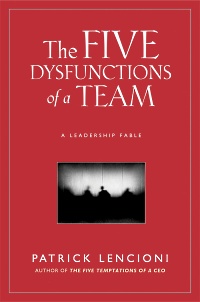
Working teams is essential for overall business success - How can your team work better together?
Just finished the following book:
The Five Dysfunctions of a Team: A Leadership Fable
by Patrick Lencioni
Jossey-Bass – 2002
ISBN-13: 978-0787960759
I give the book a 6.2/14.0. The story portion of the book was engaging and really sounded like any given day out of a normal company… thus leading the reader to assuming the lessons might be applicable to their organization. Overall, the nitty-gritty of the techniques and strategies are a little simplistic, but worth a shot. It basically boils down to: these tactics may help, but you mileage may vary.
Check out my notes from this book:
===========================================================
Five Dysfunctions of a Team:
[01] Absence of trust within the group
- confidence among team members that input is good; make team members vulnerable and be confident that others will not take advantage but help instead
- vulnerability based trust
- turn off tendencies to defend self
- Fix: personal history (high level) exercises, team effectiveness exercises (identify most important attributes of each person and single attribute that needs work), personality/effectiveness profiles (MBTI, DiSC, DOPE, etc), 360 degree feedback, experiential team exercises
[02] Fear of conflict
- All great relationships require some form of constructive conflict in order to grow and survive. Productive, ideological conflict: not personal attacks. Healthy conflict is a time-saver and more efficient – not simply rehashing the same things over and over again
- Acknowledge that conflict is productive.
- Fix: Mining: extracts historical conflicts. Real-time permission: do not retreat from healthy debate – recognize uncomfortable signs and encourage to continue/confidence. Remind people at the end that the conflict was good. Thomas Kilmann Conflict Mode Instrument (TKI)
[03] Lack of commitment
- Clarity & buy-in are needed from all members of the team – even those that voted against.
- Consensus: danger in seeking consensus – reasonable people don’t need to agree, just be reassured their ideas have been heard. Leader can make the call when stop occurs.
- Certainty: unite behind decisions and commit to plan of action even if they don’t totally agree – something better than nothing.
- Fix: cascading messaging: explicitly review decisions made and communicate to all relevant people. deadlines: use clear deadlines with discipline and rewards (startlines, too). Contingency/worst-case scenario planning: reduce fears by showing worst possible. Low-risk exposure therapy: decisions without great research/plan – just do since low risk.
[04] Avoidance of accountability
- enter the danger with one another; hole one another accountable – have high expectations for results of one another – peer pressure helps reduce bureaucracy and build community
- Fix: clarify publicly what the goals/needs/plans/standards are and keep in the open. Simple and regular progress overviews. Team rewards: peer pressure because they don’t want to lose!
[05] Inattention to results
- Seek to focus on outcome (not profit) based results. Team status: belief that altruistic goals are enough to justify alone. Personal status: increase me at cost of team.
- Fix: Public declaration of results. Results based rewards (esp. compensation), but not alone.